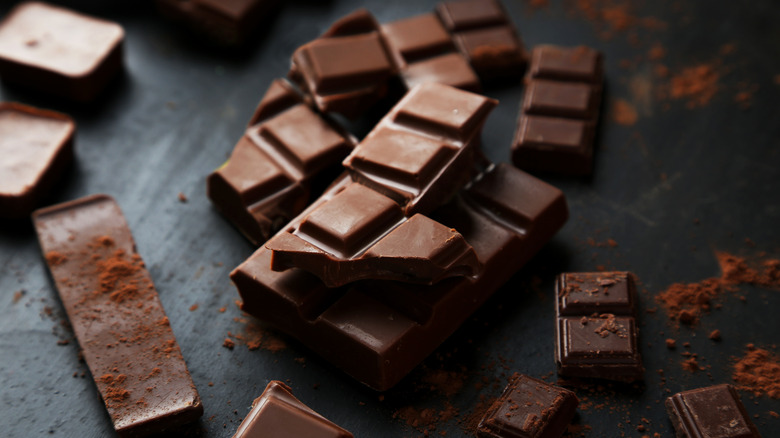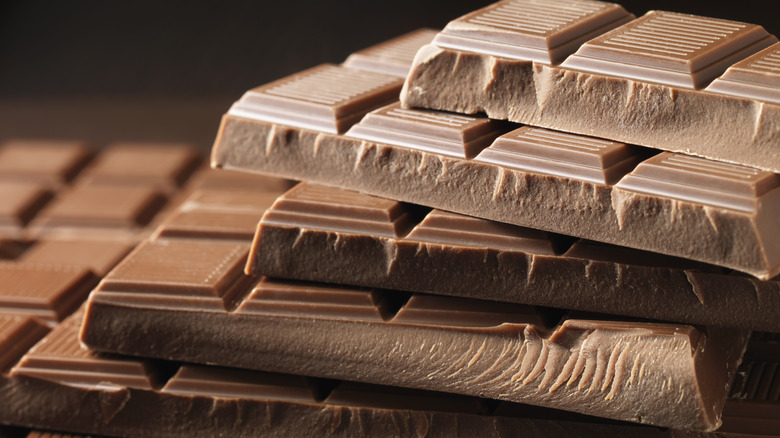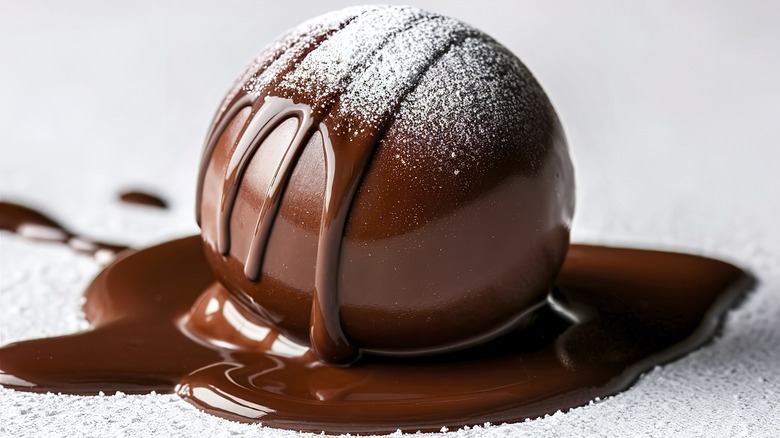The Flavor Difference Between Couverture And Compound Chocolate
All chocolate is made from the same cocoa pods that grow on Theobroma trees, yet those beans yield a huge variety of products that can be quite different. This applies to couverture and compound chocolate. Couverture is known for its rich, luxurious, and intensely chocolatey flavor that highlights the complex notes of the cocoa beans that it is made from. On the flip side, compound chocolate is more mild, usually lacks depth, and leaves a subtle greasy aftertaste. The difference is so significant that while couverture is the gold standard for everything that good chocolate should be, some believe that the compound stuff isn't real chocolate at all.
It all boils down to how those cocoa pods are processed. Once harvested, roasted, and dried, the pods are ground into a paste-like chocolate liquor. This liquor is separated into cocoa butter and cocoa solids, which are then combined in varying proportions to form different kinds of chocolate. The cocoa solids can also be pressed into cocoa powder.
Now, here's where things get different. Couverture is made by adding more cocoa butter to chocolate liquor, which gives it its superior, rich taste and texture. Cocoa butter is also the key to French chocolate's intense flavor. On the contrary, compound is made with cocoa powder and contains none of that precious butter or liquor. Instead, it uses vegetable fats like palm oil — hence the waxy aftertaste and its unfortunate rep of being known as "fake" chocolate, or a chocolate-flavored confection at best.
Compound chocolate has its benefits
If compound chocolate is seemingly that bad, why use it at all? The truth is that the lack of cocoa butter actually gives compound chocolate certain advantages. What it lacks in flavor, it makes up for in affordability and ease of use. Because it uses cheaper oils instead of high-price cocoa butter, it can be easy on the pocket.
More importantly, any chocolate with cocoa butter (including couverture) needs to be tempered — a process that involves heating and cooling melted chocolate to precise temperatures in order to stabilize its crystals of fat. Skipping past this step means that the cocoa butter will bloom, creating a chalky, cloudy white coating that forms on improperly tempered chocolate bars. You also need to temper most chocolates again at home when making things like candies and chocolate shells, or it will be bendy and soft instead of snappy; not so with compound chocolate, which can be melted and used straight away.
Plus, compound chocolate has a higher melting point, which makes it more stable and heat-resistant. You know when you rip open a bar of chocolate and find it softened into a messy puddle? That rarely happens with compound. Moreover, the use of vegetable oils over cocoa butter gives it a longer lifespan. As a result, a lot of mass-produced confections rely on compound products. That said, it's not the best idea to use it in a recipe where chocolate is the star ingredient — that is best left to the more flavorful couverture.
What is couverture chocolate used for?
Couverture is similar to a regular bar of chocolate, but with significantly more cocoa butter. Whereas standard milk and dark chocolates have 15% and 18% cocoa butter respectively, couverture requires a minimum of 31% to be labeled as such in the U.S. This not only gives the product a rich flavor, but it also affects its texture and how it is used.
For one, couverture has a more luxurious, silky, and velvety mouthfeel, meaning it is excellent eaten on its own — as a bar of chocolate, a bark, or a little bonbon. Tempering gives it a smooth, glossy sheen that compounds lack, and gives the couverture a crisp snap when it is broken apart. Because of this, couverture is the go-to for decorations, dipping, and coating. In fact, it gets its name from the French word for "to cover," which means it is ideal for any confection that needs to be covered in a generous coating of firm, glossy, high-quality chocolate, like truffles. Couverture is also the best type of chocolate to use for strawberries.
However, keep in mind that even though a lot of couverture is pre-tempered, it has to be re-tempered once melted, as the heat negates that original tempering. And though couverture can be used in baking, too, its high fat content can react differently and potentially alter your bake. When in doubt, stick to using it for dipping and coating your sweet confections.



